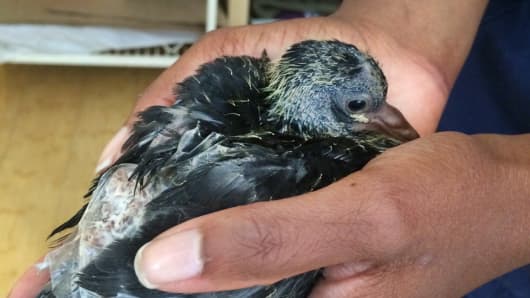Ever notice how pigeons get a raw deal? They've given us valuable service over the centuries, from delivering life-saving messages through World Wars to gracing our tables in times past as a tasty staple and as specialty "squab" in times present. And yet, they're often considered winged street rats, vermin, flying ashtrays, infested with parasites. Personally, I rather like them and their gentle cooing. And yet, I'm not going to be a hero and say I jumped at the idea of rescuing and looking after a badly injured, bleeding and abandoned baby pigeon that my son had watched since its egg time under our deck. It's not that I'm anti-pigeon, it was simply that I wasn't sure I could handle another pet death in the family, having consoled distraught kids through now-deceased hamsters, turtles, fish, lizards and even a fluffy yellow chick, accidentally hand-crushed by an over-affectionate kindergartner on "show-and-tell" day.
Anyway, after being airlifted by BBQ tongs into a hat box, "Cuddle Buzz", as the baby pigeon was named, is now thriving in the care of the wonderful folks at the Wild Bird Fund. But during the 24 hours that Cuddle Buzz was in our care, I felt like I was walking into The Secret Garden; getting a sneak peek into the world of true pigeon-lovers - the people who keep pigeons as pets. There's a passionate contingent out there that includes message forums sharing tips on favorite foods, pigeon-talk sessions with moderators, adoption centers with whimsical names like "Palomacy" and even sites to buy miracle "Pigeon Pants" so you can safely keep your pigeon inside without, well...you know.
But why don't the rest of us love pigeons? Is it because there are so many of them? Because they're not as pretty? Because they defile property, (each pigeon produces an estimated 25 pounds of poop a year)? Is it because they're thought to carry disease? I certainly don't know anyone who's gotten sick from a pigeon. I even noticed that the Wild Bird Fund itself highlighted the prettier birds like the hawks, gleaming cormorants, and quirky owls in its success story pages, despite the fact that I suspect a vast number of their rescued patients are none other than the common Central Park pigeon.
The public distaste for the boring old pigeon is not dissimilar to how market participants treat many stocks and asset classes. For example, the soft commodity boom from 2000-2010 didn't get much attention, until maybe it was ballooning. And think of the non-sexy stocks that make millions of ubiquitous things around us like elevators and escalators such as United Technologies, up over 50% in the past 3 years. Think about Johnson Controls, who among other things, heats and cools the buildings where we spend our days. It's a valuable service no doubt, but have you ever said as you're enjoying a comfortable indoor environment: "thank you Johnson Controls?" No you haven't, and yet the stock is up over 60% since spring 2012.
These are the companies which can make you a lot of money, but few people really talk about because what they do can be considered too boring and commonplace. They're the pigeons of the stock world. But as the returns can often show us, you don't have to have bright flashy plumage to be valuable.



